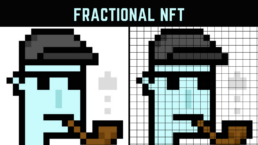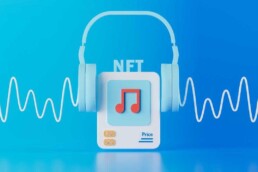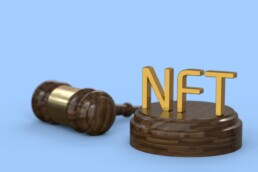What exactly are Fractionalized Non Fungible Tokens (F-NFTs) and what are the pros and cons of them?
NFTs, despite being a relatively new technology, have already gained massive traction and widespread use with $25 billion worth being bought in 2021. The key idea behind them is that it’s not possible to exchange one NFT with another unlike, for example, 1 Bitcoin which can be swapped for any other Bitcoin and still have the same value. However there is a way to make them pseudo-fungible – fractionalize them.
Fractionalization is already common in other areas of finance. Some investment platforms allow users to fractionalize share ownership and there are even platforms like Masterworks which allow for fractionalized ownership of artworks.
Two of the most popular platforms which allow NFTs to be fractionalized are Unic.ly and Fractional.art. Platforms such as these convert the ERC-721 (the Ethereum standard used to represent NFTs) NFT into multiple ERC-20 tokens (the standard used for fungible tokens). The owner can specify how many fractions to split the NFT into on the platform before the fractionalization takes place.
A fractional NFT (F-NFT) represents ownership of part of an NFT which can be divided into millions of separate fungible tokens. F-NFTs make it easier for retail investors to participate in the NFT space and improve market liquidity, although the value of the F-NFT doesn’t always match the proportional value of the whole NFT.
For example an F-NFT representing ownership of 1% of an NFT worth $100, won’t necessarily always be worth $1, they can be traded at a discount or premium to the original valuation.
In 2021 the Doge NFT was bought for 1,696 Ether (~$4 million at the time) by PleasrDAO. PleasrDAO then fractionalized the NFT into tokens called DOG and sold 20% of them, the demand for the token meant the total valuation of the NFT would have been ~$225 million.

The Pros
The main advantage of F-NFTs is that they allow smaller investors to own part of a whole NFT. This is especially advantageous when it comes to some of the more expensive ones such as those minted by CryptoPunks or Bored Ape Yacht Club which can cost millions of dollars and sometimes be impossible for the average investor to own.
In August 2022 Unique Network split ownership of a CryptoPunk NFT known as “CryptoPunk #3042” between 56,000 wallets. Unique Network CEO, Alexander Mitrovich, stated “ With our fractionalization of CryptoPunk #3042 we are heralding a new era of NFTs that are accessible, interchangeable and can be shared across chains, and at a fraction of the cost”.
Masterworks bought Andy Warhol’s “1 Colored Marilyn”, for $1.8 million in November 2017 and then sold the ownership to more than 1,300 investors 6 months later. Scott Lynn, founder of Masterworks, said this contributes towards the goal of Masterworks by making it possible for anyone to invest in the asset class through allowing investors to buy into it at an affordable price point.

For people just getting into the NFT market now, the ability to split the NFT and own just a part of it is the only way they can afford to be involved in the space. It also allows people who already hold an NFT to liquidate only part of it to raise money rather than having to sell the entire thing.
F-NFTs have been used to raise money for philanthropic causes. UkraineDAO held an auction of a Ukrainian flag NFT to raise money for people suffering from the conflict there. The NFT was fractionalized after the auction with ~2.3 million fractions currently owned by ~3,200 people. The auction raised ~$445,000 for the cause.
F-NFTs are also gaining utility in other areas. Axie Infinity, an NFT based online video game, is testing the use of F-NFTs within the game by fractionalizing “Axies”, one of the games’ most popular NFT assets.
The growth of the Metaverse over the next decade will surely provide more and more applications of F-NFTs as well. There are however negatives to the development of F-NFTs, not least the regulatory issues that could impact the industry.
The Cons
The Security and Exchange Commission’s (SEC) Hester Price (also known as “crypto mom” due to her support of crypto in an institution that hasn’t always viewed it positively) has warned that F-NFTs could be seen as securities and anyone selling them should be careful.
Securities are fungible assets used to raise capital and would therefore require sellers to register with the SEC and offer personal information about the seller and asset, completely different to how most F-NFTs are sold today.
Asking creators to provide this information to regulators would go against the decentralization and anonymity that is a cornerstone of the NFT and crypto community. There isn’t clear regulation over this yet but the SEC is following it closely and has already investigated some F-NFT issuances according to Bloomberg.
The test used to establish whether something is a security or not is the Howey Test, named after the SEC v. W.J. Howey Co. case in 1946. There are 4 parts to the test, all of which must be met for something to be defined as a security. These are whether the offering involves:
-
An investment of money.
-
A common enterprise.
-
Reasonable expectation of profit.
-
Whether it originates from an entrepreneurial effort.
According to these laws it’s likely some F-NFTs will be viewed as securities by regulators whilst others may not. It’s difficult to define whether one has a reasonable expectation of profit when making the original NFT or not. Could the creators of the “Success Kid” or “Bad Luck Brian” meme NFTs have predicted they would one day sell for tens of thousands of dollars? Did they produce them with entrepreneurial effort or just for fun?


“Bad Luck Brian” and “Success Kid” are 2 of the most famous memes around today and both have been turned into NFTs but could the people who minted them have known they would be so valuable one day?
Masterworks has an interesting setup to allow it to sell fractions of artworks to investors. It first buys a painting and files it with the SEC as an IPO, much like a company does. “Shares” in the painting are then made available for purchase on the Masterworks website, with the minimum amount normally being $20 per “share”.
They even added a secondary market recently, giving investors the option to trade shares in paintings and sell them before a liquidity event. In the future NFT platforms could set up a similar system to this and try to register NFTs with the SEC before selling them, hopefully making the whole industry less of a target for regulation.
Regardless of what happens, the issue is unlikely to disappear anytime soon and SEC involvement and scrutiny will probably grow over time, with regulation regarding F-NFTs evolving faster and differently than for whole NFTs. The outcome is certain for neither though given their nascency and the contrasting views of those within the SEC towards them.
Re-connecting the NFT after it’s been fractionalized can also cause issues, something known as the reconstitution problem. Basically, if the creator sells 50% of the NFT and then wants to do something with it, it could be difficult to do since they don’t control over half of it and therefore the rights to it. Most F-NFT platforms however do offer ways to reconstitute an NFT via buyout auctions but the owner should ensure the platform offers this capability before they pick a platform to fractionalize an NFT.
Conclusion
With the future growth of the NFT industry, F-NFTs are likely to become even more prevalent and new uses for them will be found as their popularity grows. Their ability to allow smaller investors an entry into the NFT space combined with their importance to the development of the Metaverse and transactions within it mean demand for them and their prevalence is only likely to rise.
Get more insights like this on the business and marketing of the metaverse delivered to your inbox. We’ll never spam you, ever.
Harry Harrison
After spending 3 years traveling around Australia and Asia I began writing about finance whilst stuck at home at the beginning of 2020 thanks to Covid. I've always had a strong interest in business and technology and he thoroughly enjoys learning more about anything connected to the Metaverse, NFTs or crypto. In my spare time he enjoys playing soccer, pool or chess and reading about history, science and technology.
Related Posts
December 8, 2022
Overview of NFT Use in the Music Industry
NFTs are a new technology set to revolutionize many old industries. One of…
December 6, 2022
The Impact of The Merge on NFTs
The Merge has been perhaps the most important development to the Ethereum…
December 1, 2022
How The SEC Might Regulate NFTs
The Securities and Exchange Commission (SEC) has taken a somewhat critical view…



